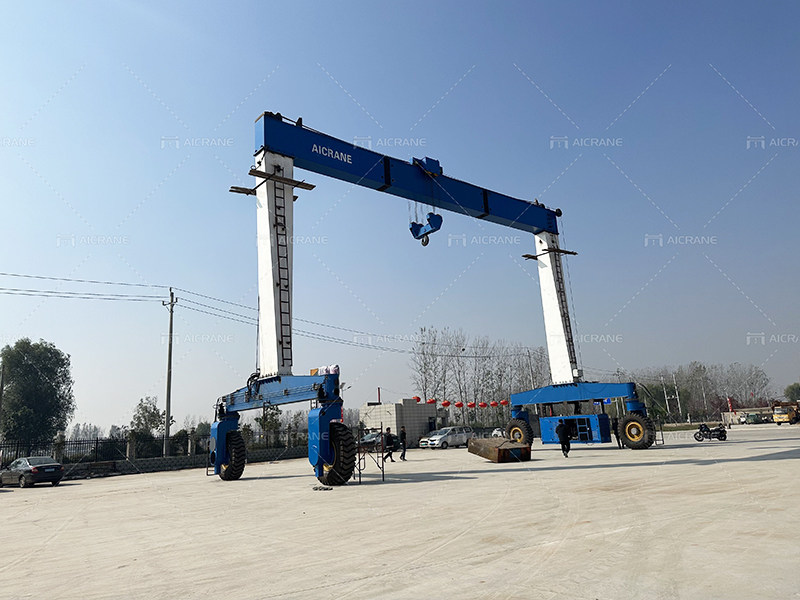In the ever-evolving landscape of industrial and shipping operations, the need for efficient and versatile lifting equipment is paramount. Traditionally, fixed lifting solutions have been employed in various industries, but the emergence of rubber-tyred gantry cranes (RTGs) has revolutionized the way materials are handled. RTGs offer a host of advantages over traditional lifting equipment, providing a more flexible and efficient solution for modern logistics and container handling operations.

Mobility and Flexibility
One of the primary advantages of rubber-tyred gantry cranes is their exceptional mobility and flexibility. Unlike traditional lifting equipment, such as fixed cranes or forklifts, RTGs are mounted on rubber tires, enabling them to move easily within the operational area. This mobility allows for dynamic positioning and efficient utilization of space in container yards and storage facilities. RTGs can travel at variable speeds and navigate sharp turns, making them highly adaptable to changing operational requirements.
Space Optimization
Traditional fixed cranes occupy a significant amount of space due to their stationary nature and the need for extensive infrastructure, such as rails or concrete foundations. In contrast, RTGs operate on rubber tires and can move freely across the yard. This eliminates the need for fixed paths, enabling better space optimization. RTGs can be positioned more closely together, maximizing storage capacity and streamlining the container handling process.
Quick Deployment and Redeployment
Rubber-tyred gantry cranes offer a rapid deployment advantage compared to traditional lifting equipment. RTGs can be easily transported to different locations within the facility, allowing for quick setup and operation. This flexibility is particularly valuable in dynamic logistics environments where the demand for container handling services may vary. Additionally, the ability to redeploy RTGs swiftly contributes to operational efficiency and responsiveness to changing business needs.
Enhanced Productivity
The mobility and flexibility of RTGs translate into enhanced productivity in container handling operations. These rubber tired gantry cranes can efficiently move between rows of containers, picking up or placing loads with precision. The increased speed and agility of RTGs result in shorter cycle times, reducing overall handling time and improving the throughput of goods. As a result, businesses can achieve higher levels of productivity and meet the demands of a rapidly moving supply chain.
Remote Operation and Automation
Another advantage of rubber-tyred gantry cranes is the potential for remote operation and automation. With technological advancements, operators can control RTGs from a centralized location, reducing the need for on-site personnel. Automation features, such as automated container stacking and retrieval systems, further enhance efficiency and reduce the risk of human error. The integration of smart technologies in RTGs aligns with the industry’s move towards digitalization and Industry 4.0 practices.

Environmental Considerations
In an era where sustainability is a key consideration for businesses, the environmental advantages of RTGs are noteworthy. Traditional lifting equipment, especially those powered by fossil fuels, can contribute significantly to air pollution and carbon emissions. In contrast, many RTGs are designed to be electrically powered, reducing their environmental impact. Furthermore, innovations such as regenerative braking systems contribute to energy efficiency, making RTGs a more eco-friendly choice compared to traditional lifting equipment.
Reduced Infrastructure Costs
The infrastructure requirements for traditional lifting equipment, such as fixed cranes, often involve substantial costs related to the installation of rails, foundations, and other stationary components. Rubber-tyred gantry cranes, being mobile and not reliant on fixed infrastructure, result in reduced installation and maintenance costs. This cost-effectiveness makes RTGs an attractive option for businesses looking to optimize their capital expenditures while maintaining high operational standards.
Conclusion
The advantages of rubber-tyred gantry cranes over traditional lifting equipment are clear, encompassing mobility, flexibility, space optimization, quick deployment, enhanced productivity, remote operation, environmental considerations, and reduced infrastructure costs. As industries evolve to meet the challenges of a rapidly changing global market, the adoption of innovative solutions like RTGs becomes crucial for staying competitive and efficient in container handling operations. The future of material handling undoubtedly leans towards the versatility and efficiency offered by rubber-tyred gantry cranes, shaping the landscape of modern logistics and supply chain management. To learn more about lifting equipment, click here https://steelmillcranes.com/
